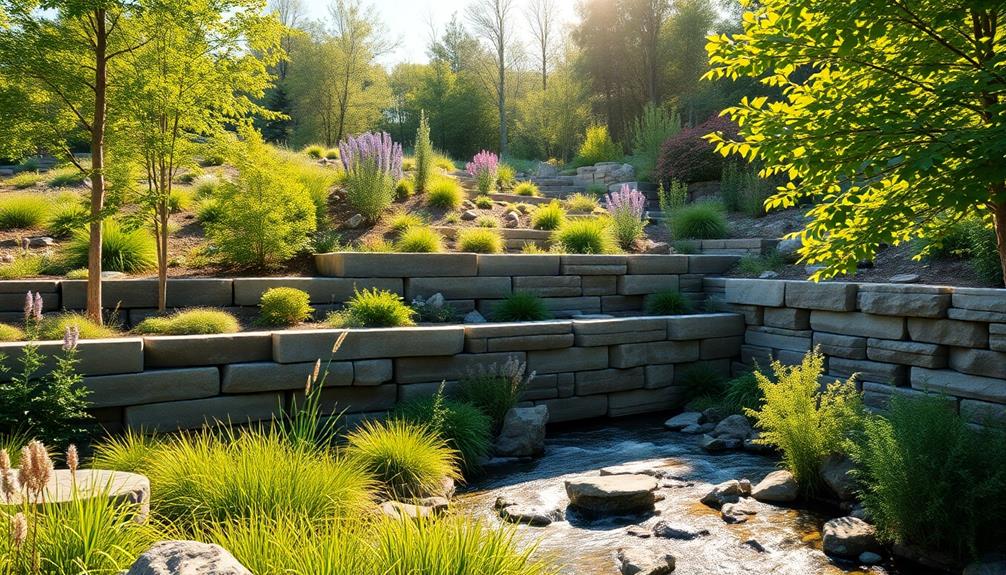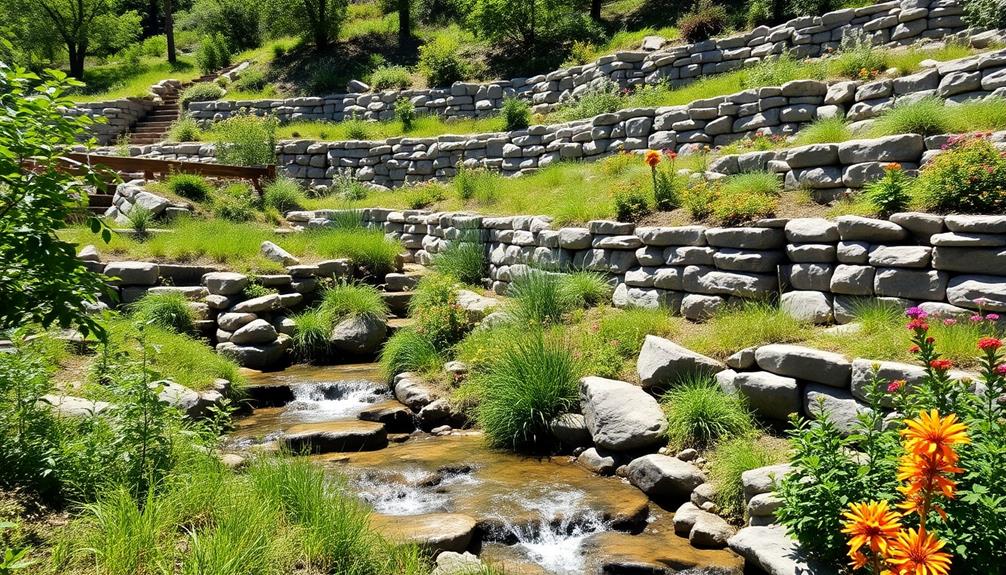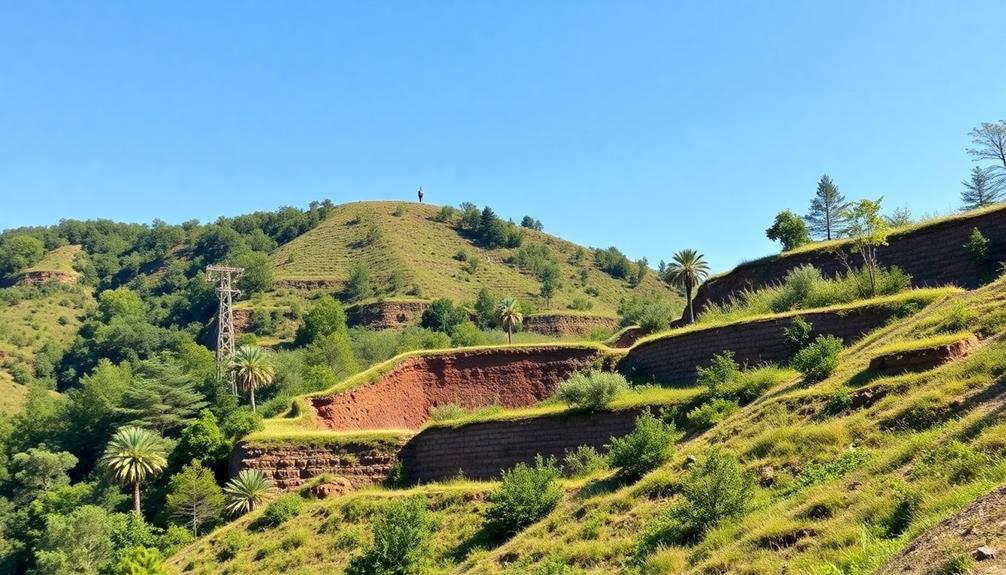Environmental impact in retaining wall construction is fundamental for sustainable development and ecological preservation. By conducting thorough environmental assessments, builders can pinpoint vulnerable landscapes and adapt strategies to minimize disruption. Sustainable material selection not only conserves resources but also integrates environmentally friendly alternatives, ensuring durability and a seamless blend with the local ecosystem. Advanced water management strategies mitigate erosion and protect both the structure and surrounding habitats, while enhancing soil stability through bioengineering creates a balance between human infrastructure and nature. Considering these elements not only preserves structural integrity but also aligns construction practices with ecological objectives. Discover how these considerations shape environmentally responsible construction practices.
Table of Contents
ToggleWalls Contractor Highlights
- Environmental impact ensures retaining walls align with ecological goals, minimizing habitat disruption and promoting sustainability.
- Responsible construction methods protect soil stability and manage water flow, reducing erosion and potential ecosystem damage.
- Sustainable material selection reduces carbon footprint, conserving resources while maintaining structural integrity.
- Understanding local climate and soil properties is crucial for effective design, ensuring the wall's longevity and environmental harmony.
- Engaging stakeholders fosters collaboration, integrating community input for ecologically sensitive planning and construction.
Environmental Impact Consideration

In the construction of retaining walls, it is vital to contemplate strategies that minimize ecosystem disruption by carefully selecting locations and construction techniques that preserve natural habitats. Utilizing materials like boulder walls, which are eco-friendly and require minimal maintenance, can additionally minimize the environmental impact.
Employing sustainable materials not only reduces environmental strain but also contributes to the longevity and resilience of the structure. Additionally, implementing effective water management strategies can prevent soil erosion and safeguard local water quality, thereby ensuring that retaining wall projects harmonize with surrounding ecosystems.
Minimizing Ecosystem Disruption
Preserving the integrity of local ecosystems is paramount when constructing retaining walls, as these structures can create significant disturbances. Ensuring minimal disruption requires careful planning and execution to maintain the delicate balance of flora and fauna. This begins with a comprehensive environmental assessment to identify key features and vulnerabilities within the ecosystem. Such evaluations guide construction planning to avoid critical habitats and migration routes, hence reducing potential harm.
Precise site selection and design modifications play indispensable roles in ecosystem preservation. Employing non-invasive building techniques and machinery minimizes soil and vegetation disturbance, which helps in maintaining local biodiversity. Techniques such as contour grading can be employed to conform to natural landscapes, preventing soil erosion and promoting water management that mimics natural hydrological patterns.
Engaging with local environmental agencies and community stakeholders fosters collaborative decision-making, ensuring that retaining wall designs support, rather than disrupt, native ecological networks. By utilizing local knowledge and expertise, construction projects align more closely with community values, enhancing ecological stewardship. Additionally, incorporating vegetation into wall designs can aid in conserving habitats and boosting aesthetic appeal. Such integration not only preserves environmental integrity but also strengthens community bonds around shared ecological values.
Sustainable Material Selection
Selecting sustainable materials is essential in reducing the environmental impact of retaining wall construction. Such choices pivot on promoting ecological harmony while achieving structural integrity and aesthetic appeal. Incorporating recycled or reclaimed materials not only conserves resources but directly reduces emissions associated with new material production. For instance, utilizing recycled concrete or timber in retaining walls diminishes landfill waste and spares natural environments further exploitation. In addition, sourcing materials locally minimizes transportation impacts, reducing carbon footprints, and further integrates the retaining wall with its local milieu, fostering a shared commitment to environmental stewardship.
Robust materials like gabion baskets utilize natural stone and wire mesh, allowing for substantial strength while promoting natural water filtration and plant growth within the wall structure. Similarly, living walls, incorporating vegetation like moss or succulents, offer aesthetically pleasing options that also enhance air quality and biodiversity. The selection of permeable materials aids in the natural absorption and drainage of water, thereby preventing soil erosion and minimizing the risk of flooding. Prioritizing these environmentally considerate materials in your retaining wall design aligns construction efforts with broader ecological goals, creating spaces that resonate with a shared responsibility for maintaining a healthy planet.
Water Management Strategies
How do effective water management strategies influence the environmental impact of retaining wall construction? Implementing effective water management strategies plays a pivotal role in mitigating erosion, preserving local ecosystems, and guaranteeing the longevity of retaining structures. Strategic approaches to water control in retaining wall projects contribute crucially to their environmental sustainability by preventing overflow and erosion that can undermine structural integrity and damage surrounding habitats. This involves carefully designing and integrating systems to manage water flow both during construction and throughout the life of the wall.
Consider these indispensable strategies:
- Drainage Design: Implementing proper drainage techniques, such as weep holes or geotextile fabrics, prevents water accumulation behind the wall, reducing hydrostatic pressure and ensuring structural stability. A well-designed drainage system minimizes erosion and sediment transport, essential for protecting nearby ecosystems.
- Groundwater Management: Systems to monitor and control groundwater levels can prevent unexpected saturation and movement that may threaten both the wall itself and nearby landscaping. Advanced engineering solutions, like subsurface drainage systems, can redirect groundwater effectively, preserving ecological balance.
- Surface Water Diversion: Strategies such as grading and the construction of surface channels ensure surface runoff is appropriately directed away from the wall. This prevents surface erosion and protects downstream environments, thus fostering community and environmental harmony.
These strategies underscore the critical role water management plays in environmentally responsible retaining wall construction.
Benefits

Retaining wall construction offers significant environmental benefits by enhancing soil stability, which is essential in preventing landslides and protecting valuable landscapes. Additionally, the integration of bioengineering techniques promotes biodiversity growth, creating habitats for various flora and fauna.
Furthermore, incorporating methods like riprap can further protect shorelines by blending with the natural environment and reducing the need for maintenance. The use of eco-friendly materials and methods reduces the carbon footprint associated with construction projects.
Additionally, these structures also play a pivotal role in minimizing erosion risks, thereby safeguarding both natural ecosystems and human developments from the adverse effects of soil degradation.
Enhances Soil Stability
Integrating retaining walls into landscaping and construction projects offers a crucial advantage by enhancing soil stability, thereby preventing erosion and soil movement. These structures serve as indispensable components in maintaining the structural integrity of land, especially in areas susceptible to erosion or shifts due to water runoff. Their utility extends beyond mere functionality, contributing to a community's sense of security and cohesion by safeguarding both public and private properties.
Retaining walls act as physical barriers, considerably reducing the force of flowing water and preventing the relocation of soil, which is essential in preserving the original landscape design and reducing land degradation.
Engineers design retaining walls to channel water away from vulnerable areas, hence strategically controlling water flow and minimizing impact on soil surfaces, leading to more stable and manageable terrains.
They maximize the usability of inclined areas by effectively transforming slopes into functional terraces, thus expanding available land for cultivation, recreation, or construction. This transformation can strengthen a community's connection to its environment by making more efficient use of the land.
Promotes Biodiversity Growth
By fostering varied microhabitats, retaining walls can considerably promote biodiversity growth. These structures provide unique niches that enhance ecological diversity, supporting a mosaic of life forms ranging from bacteria to birds. Retaining walls can be deliberately designed to include crevices and ledges where native plant species can take root. In this manner, vegetation flourishes, it forms the basis for a thriving ecosystem, attracting pollinators like bees and butterflies, which, in turn, support bird populations. This intricate web of interactions nurtures a unity within the environment, satisfying our intrinsic desire to coexist harmoniously with nature.
Moreover, the microclimatic conditions created by retaining walls— variations in sunlight, moisture, and temperature—facilitate diverse living conditions for various species. This serves not only to preserve existing biodiversity but also to foster the regeneration of ecosystems. Vegetation choice is paramount; native species are preferred for their adaptability and symbiotic relationships with local fauna. These strategic designs cultivate robust habitats resilient to environmental stresses, emphasizing the dual role of retaining walls as both functional engineering feats and instruments of ecological stewardship.
Reduces Carbon Footprint
A critical benefit of retaining wall construction is its potential to dramatically reduce the carbon footprint associated with traditional construction practices. This reduction is achieved through various innovative and environmentally responsible approaches that appeal to a community-conscious audience. In alignment with a shared commitment toward sustainability, adopting such practices promotes more responsible land development.
Key methodologies contributing to a lower carbon footprint include:
- Material Efficiency: Utilizing eco-friendly materials, such as locally sourced and recycled products, minimizes the energy consumption involved in transportation and processing. By sourcing materials from nearby suppliers, the environmental impact and carbon emissions are considerably diminished.
- Innovative Design: Implementing sophisticated, energy-efficient construction techniques, such as geogrid reinforcement, not only enhances the stability and durability of retaining walls but also substantially lower the demand for resource-intensive construction materials.
- Reduced Machinery Usage: The implementation of construction technology that lessens reliance on heavy machinery diminishes overall fuel consumption. By employing advanced, less invasive tools, the carbon emissions normally discharged in traditional construction decrease markedly.
Through these strategies, communities invested in cultivating an eco-friendly environment can confidently rely on retaining wall construction to contribute effectively to their sustainability objectives.
Minimizes Erosion Risks
Retaining walls play a pivotal role in minimizing erosion risks, a benefit that substantially enhances land stability. Constructed with precision, these structural systems serve as a critical barrier against the forces of sliding soils and water flow, elements frequently responsible for erosion. By providing essential support to soil on sloped landscapes or near water bodies, retaining walls effectively mitigate soil displacement. This intervention not only helps in maintaining the integrity of the terrain but also fosters a safer environment for infrastructure and native ecosystems alike.
Additionally, in environments where community cohesion and safety are prioritized, proper erosion control achieved through retaining walls can prevent detrimental effects on nearby properties, reducing potential conflict and fostering harmonious living. This thoughtful application of engineering principles not only reflects an environmental mindfulness but also empowers communities to take proactive steps in preserving their land.
In the context of sustainable construction practices, retaining walls illustrate a commitment to harmonizing human development with nature's demands. They serve as an embodiment of the delicate balance between progress and preservation, demonstrating that thoughtful design can effectively uphold both structural integrity and environmental health, in turn nurturing a shared sense of belonging to our landscapes.
Soil Erosion Prevention Factors

In addressing soil erosion during retaining wall construction, three pivotal factors come to the forefront: effective integration of vegetation, innovative water drainage solutions, and meticulous material selection. Vegetation not only anchors the soil but also enhances structural integration, while drainage solutions are critical to managing water flow and reducing hydrostatic pressure behind the wall. Selecting the appropriate materials guarantees compatibility with the environment, enhancing the wall's durability and minimizing ecological disturbance.
| Factor | Description |
|---|---|
| Vegetation Integration | Enhances soil stability and structural integration |
| Water Drainage Solutions | Manages water flow and reduces hydrostatic pressure |
| Material Selection | Guarantees environmental compatibility and structural durability |
Vegetation Integration Strategies
Effective integration of vegetation in retaining wall construction can play a pivotal role in soil erosion prevention. By strategically incorporating plant life, builders can create sustainable and environmentally friendly barriers that not only prevent soil degradation but also enhance the aesthetic appeal and ecological health of the construction site. Vegetation offers natural reinforcement to retain soil on slopes and embankments, mitigating the erosion processes that can undermine the stability of retaining structures.
Key Vegetation Integration Strategies:
- Selection of Native Plant Species: Utilizing indigenous plant species guarantees adaptability to local climate conditions and soil types, promoting robust growth and minimizing maintenance. Native plants typically have deep root systems which stabilize the soil effectively.
- Strategic Planting Patterns: Arranging plants in layers or staggered rows creates a dense root matrix, enhancing water absorption and decreasing surface runoff. This pattern not only reinforces the soil structure but also supports biodiversity by providing diverse habitats for various species.
- Incorporation of Grasses and Ground Covers: These plants cover large areas and grow quickly, providing immediate protection against erosion. They effectively shield the soil from wind and rain impact, preserving the integrity of the land and guaranteeing long-term resilience.
Together, these strategies serve not just as functional elements, but as integral components of community-focused construction endeavors that prioritize environmental stewardship and sustainability.
Water Drainage Solutions
Addressing water drainage effectively is critical to preventing soil erosion in retaining wall construction. Ensuring proper water management involves integrating carefully designed systems that channel water away from the wall structure, consequently maintaining the integrity of the soil. Essential to this process are drainage pipes and gravel backfills, which work in unison to facilitate the swift removal of water, minimizing hydrostatic pressure that can compromise stability. An understanding of local climate and soil properties becomes paramount, as these factors dictate the drainage solutions required to mitigate soil erosion effectively.
Incorporating weep holes into retaining wall designs can promote adequate drainage, allowing water to escape and thereby alleviating pressure buildup within the wall. The implementation of a filtration fabric behind the wall enhances this system, preventing soil from clogging drainage paths. Collectively, these solutions forge a line of defense against the deleterious effects of erosion, fostering a retaining wall system that harmonizes with the environment it supports.
Material Selection Considerations
Selecting appropriate materials for retaining wall construction is vital in mitigating soil erosion and preserving long-term stability. The materials chosen must effectively resist erosion while blending harmoniously with the surrounding environment. This calls for thoughtful consideration of several factors, which help in fostering an enhanced sense of community by preserving the natural landscape.
Durability and Strength: Materials need to withstand the elements over extended periods. Concrete, stone, or reinforced earth structures are commonly recommended because they offer high durability and strength, preventing soil displacement and erosion.
Eco-Friendly Alternatives: Adopting materials like recycled plastics or sustainably sourced timber not only contributes to environmental conservation but also aligns with the community's commitment to sustainability. These materials can offer an effective barrier against soil erosion while minimizing the ecological footprint.
Aesthetic Harmony: The retaining wall should seamlessly integrate with the local ecosystem, providing an aesthetic aspect that enhances the sense of belonging within the community. Materials should be selected to complement the natural surroundings, thereby fostering a cohesive and appealing environment.
Choosing materials that address these essential factors will guarantee a durable, environmentally sensitive, and visually pleasing retaining wall construction.
Walls Contractor FAQ
What Materials Maximize the Sustainability of Retaining Walls?
To maximize sustainability in retaining wall construction, consider using materials such as recycled concrete, sustainably sourced timber, and eco-friendly geotextiles. These options align with environmentally conscious practices, making stakeholders part of a proactive community that values sustainability.
How Does Retaining Wall Design Affect Local Wildlife Habitats?
Retaining wall design drastically influences local wildlife habitats by altering natural landforms and water flows. Thoughtful integration, considering wildlife movement corridors and natural vegetation, fosters ecological balance and supports biodiversity, enhancing the communal sense of harmony with nature.
What Are the Potential Impacts of Drainage Systems on Surrounding Ecosystems?
Drainage systems in retaining walls can alter local water flow, affecting soil moisture levels and potentially harming surrounding ecosystems. This can lead to habitat disruption, erosion, and reduced water quality impacting local flora and fauna.
Are There Eco-Friendly Alternatives to Traditional Retaining Wall Construction Methods?
Yes, sustainable alternatives include using gabions, living walls, or recycled materials. These options minimize environmental impact while fostering ecological harmony. Such practices not only preserve nature but also promote inclusivity within environmentally conscious communities, aligning with shared sustainability goals.
How Can Retaining Walls Be Integrated Into Green Infrastructure Planning?
Integrating retaining walls into green infrastructure involves selecting sustainable materials and designs that complement natural landscapes, enhance biodiversity, and manage stormwater. Collaboration among planners and communities fosters cohesive development strategies that align with shared environmental stewardship goals.







